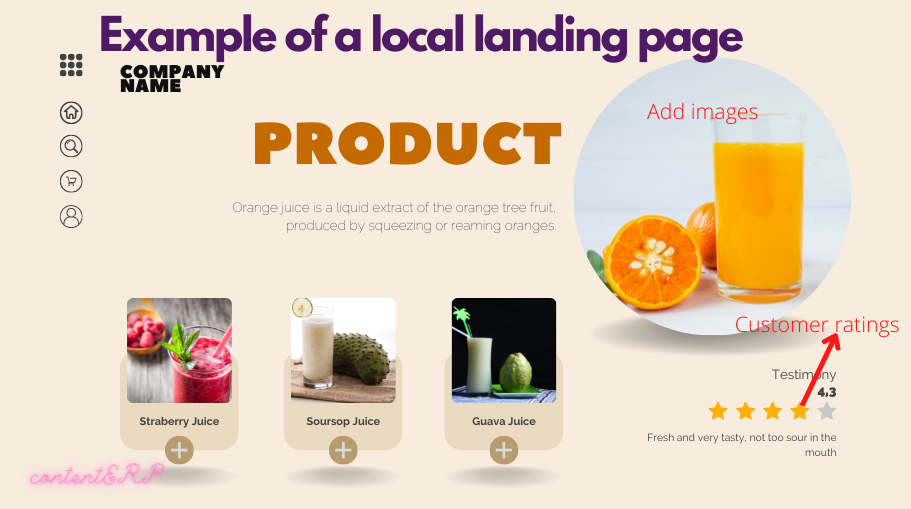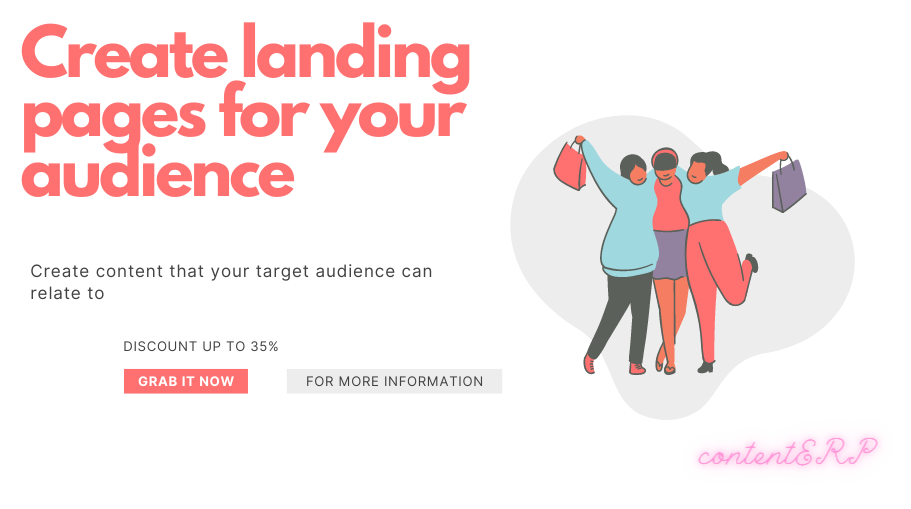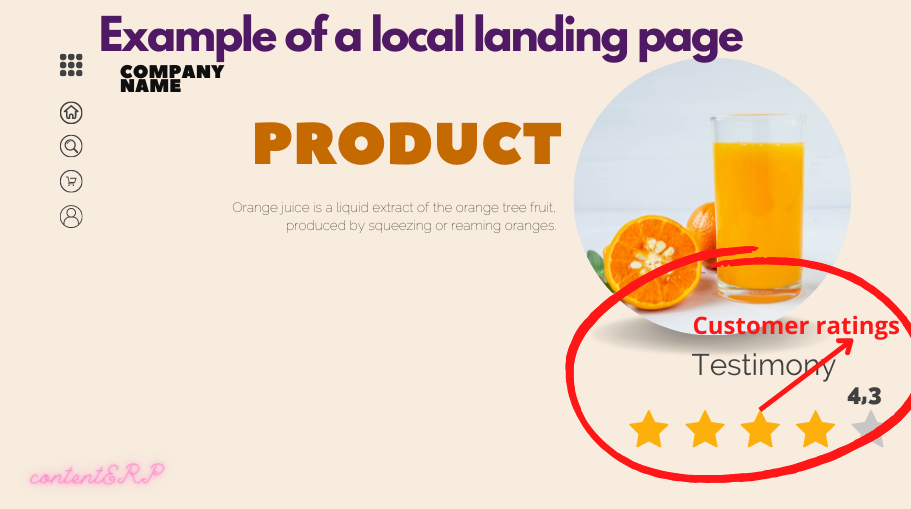How to create content for local landing pages in SEO

Creating content for your local landing pages can be slightly different than regular website content. When you’re writing for your local landing pages, you want to make sure that you include certain key elements that will help you attract visitors and rank higher in search engine results pages (SERPs).
When it comes to search engine optimization (SEO), local businesses have a significant advantage. Unlike larger businesses, local businesses can focus their efforts on optimizing their website for one specific location, allowing them to target potential customers in their area effectively.
One of the best ways to optimize your website for local SEO is by creating landing pages for each service area. These pages should include detailed information about the services you offer, as well as local business listings and links to your Google Maps profile.
What is A Local Landing Page?
A local landing page provides products and services that appeal to one or more specific geographic markets. A local landing page for a brick-and-mortar store is a single webpage designed to attract customers in a given market.
The page’s content should be tailored to the neighborhood’s geographic and cultural geography. Businesses with multiple locations or service areas should create separate web pages for each place of operation.
Difference between a home page and a landing page
On the home page of a commercial business appears a list of safeguards (sales copy), a selection of premises, products, and services, as well as some images designed to appeal to customers.
The landing page highlights a specific service, product, or campaign. A local plumber with a landing page with notice of rates suggested first-time remodel projects would attract customers.

Benefits of Local Landing Pages
Local Landing Pages Improve Local Search Authority
Local landing pages are most effective for attracting and converting customers who make local searches, especially during the COVID-19 pandemic. 48% of searches on your smartphone lead to a purchase on the same day. Moreover, 50% of consumers searching for a store on their smartphone reported that they would purchase from that store the same day.
Local Landing Pages Give You a Platform to Publish Unique Local Content
When creating a local landing page, you might begin with content sharing locally relevant information. For example, a community ingredients directory or a directory of local events and activities.
You can make your landing pages accessible as archival posts to let others see what was published at a specific location; these archives can show trends that viewers might have missed. You might also have a blog highlighting itineraries, menus, special features, artwork, and other content associated with your restaurant to let local customers tour the venue and network with staff.
Local Landing Pages Increase Lead Generation Opportunities

A local landing page improves lead generation opportunities outside of publishing unique content for local pages. News sites, local blogs, and vacation guides are even more likely to link to a local page for links.
When your landing page can rank well for local search queries, you attract additional visits from local customers. Your landing pages might not be necessary for every business, but it’s a good way to generate leads without publishing content. Some companies may also claim their Google My Business listing, Yelp, and similar local directories like SimplyBusiness to attract more visitors and increase their
Landing pages for online businesses?
Yes, local landing pages may help with business consulting. For example, if you provide business consulting services, you may create a local page for cities like San Francisco, Chicago, and New York as a business benefit.
Local landing pages best practices
Targeting Your Audience
While you may be tempted to create a local landing page for each city where you could conceivably have customers, it is not likely to be a good use of your time.
Do: Focus on the regions or cities that provide your business the most value. Find areas with the highest business interest and the greatest number of opportunities for your company. If your business provides the greatest meaning to those areas — social impact being a big sticking point — then local landing pages could work better than national landing pages. Your audience would be more likely to be in a place where the biggest return is realized. For example, the usage of pandemic ads for 60 days is at
Don’t: Target too many locations. This could potentially make your placement experience put you in a tempting position—to cut and paste your content and duplicate your landing page content in multiple places while changing locality. This is a big no-no!

Alternatively, land your content writer with the grueling task of trying to write the same thing in a thousand different ways. For example, if you’re a business selling athletic gear, build local landing pages for cities with strong football teams. The point is to be strategic in choosing which cities you want to place content before you set about crafting marketing copy and building out landing pages for more than just a handful of
Keyword Targeting
Google recognizes what you are after, although keyword planning may be a matter of fact. As a first principle, we would better serve our customers by writing it all from a copywriter’s perspective, to let the end product interpret every word just like a user would. It would help if you wrote about how you operate, the projects carried out, what we can do for you and how we achieve a satisfied customer. Any professional copywriting rule would support that claim.
Defining Your Landing Page’s Purpose
Create a beautiful relationship with your audience by providing the content they seek. Let them see the value in working together, not just the fact that you offer what they want. Do not just brag about your company: show instead how your company can solve a customer’s problems. Make them go looking for more, not for confusion.
Your content should not only be about the website or page that will stay on top of the search engine results but should also serve the user well with great content. You want the search engine results to be about what you and your visitors want to see, which means not creating dumb landing pages that serve only to go to peripheral pages after another click or two. In turn, think about your own experience as a user, and don’t put content in the search engine results that you do not believe to be useful to people. Too often, local pages expect you to have more knowledge of the topic than we usually grant to the average city-dweller. Instead, work to build one informative page that serves the purpose you want it to.
Writing Unique, User-Centric Content
The worst thing you can do while designing local landing pages is to use the same copy or wording (no matter where) on many sites.
Attribute the content differentiating it from the landing page. Consider the special attributes of the state or city, your target audience, and the local area. There are many questions to answer, such as: – What is your business best known for? What is your company’s current website or presence online? – Why should your business’s content be advertised on the site?
Create custom landing pages that are very different from one another. Create pages that specialize on the client you’re trying to reach. Keep your pages fresh by injecting new events, unexpected experiences, and special deals. Listen to your audience, ask questions, and be creative. Let your brain solve the problem!
Meta Title & Description
You will also need a title and description separate from the headline and subheadline. This information shows up as a preview in the search results. That should always include your target key phrase and location. These should help searchers find your content and draw them to click. Example preview for meta title and meta description in an SEO search.

Description of Offers
Indicate service areas as mentioned above. For those operating restaurant types of businesses, these offer service help. A service-oriented business relates to establishing the offerings and services offered. For example, a drain-clearing service establishment might include the removal of obsolete countertops and slop tubs, as well as low-level trench-water extraction by using heavy-duty.
Standardized NAP
NAP (name, address, and phone number) is a location-specific optimization practice in local SEO. Usually, every website feature inside a locales map should use the same information because (they know who is who and are verified in their other listing). All listed have to be connected. Therefore SPOT on your local landing page, submit, and listings in online directories. Use your business name exactly.
Embedded Map
A map makes it easier for users to find, understand, and visualize your physical location in relation to landmarks in the area. The Internet makes it simple for users to navigate and embed maps into websites – specifically, WordPress.
Location Specific Hours
Each landing page on your website should also list specific opening hours for that location. Also, if the business is closed on specific holidays, be sure to include those dates.
DO NOT use the small business fact box at the bottom of the tab for this. Google would then show that information if we click the small business box and see it in our search results. Instead, display this information on an associated location tab.
Publish Unique Local Content
Local content serves to identify the place we are advertising. For example, you might include local awards or recognitions (for example Voted Best Burger in the city), information about local staff, or weekly ads for that specific location. Researchers are more likely to call again and for a longer period, especially if the experience was positive. Some research findings in health economics come from specific markets where marketing budgets are controlled.
Supporting Images or Videos
Images help both users and search engines understand what your content is about. When used well, they enhance user experience, boost website rank, enhance search engine results, and create a favorable impression on people for digital content such as images and videos. All your images should have alt text and titles for SEO and accessibility.
Optimize for Mobile
Home builders know that it is critical to check the appearance of mobile landing pages before launching a site. However, they are not always clear on optimizing mobile devices. To remedy this, Google has a tool that makes examining your performance easy. It will tell you how your page performs, and it’s a good idea to test your Mobile-Friendliness.
Customer Reviews

Once the best method for increasing customer visits is to have firsthand customers say positive things about your business. You increase the chances of returning business by posting or embedding reviews from sites such as Yelp or Google.
Internal Links
Attaining excellence in internal linking optimization is critical to ensuring you are properly optimized for search engines, tracking and measuring web traffic efficiently and optimally on map and location pages like this site.
This way, visitors from all locations around your store will flow off the top pages and into the location pages of your catalog. It is easy for some. For others, it might be a bit of a challenge to establish the relationships that will allow me to create a linking domino effect of links from the top or catalog to directory and parent directory pages.
Conclusion
This article discussed some local important concepts and overlaps you need to understand as you build your website. To start with, let’s do some background research if you need that. This will show you where the right keyphrases to focus on are, and then think about how the local landing pages will integrate into your website structure. After that, you have to lay some basic SEO specifications so that your page is optimized but also make sure it’s findable and user-friendly to your users.

